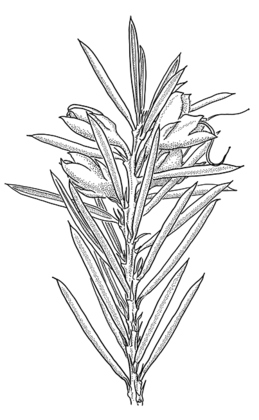Common name: Bucketty Bush-pea
Pultenaea renneri R.L.Barrett & Clugston APNI* Synonyms: Pultenaea sp. Bucketty (C.Burgess s.n., 28 Sept. 1963) APNI*

Description: Erect shrub 1–2 m; branchlets glabrous.
Leaves alternate, ±linear, (3.3–)4.8–12.2 mm long, 0.5–0.8 mm wide, apex acute, margins moderately to tightly inrolled but not enclosing upper surfaace, surfaces discolorous, lower surface green on sides with a dark red-brown medial stripe, darker than glaucous-green upper surface; stipules 1.6–2.3 mm long.
Inflorescence irregular, not terminal, losely clustered, leafy, the leaves sometimes smaller and with enlarged stipules; bracts absent. Flowers 7.5–10 mm long; pedicels 1.2–2.0 mm long; bracteoles 1.6–1.7 mm long, lacking stipules, narrow-triangular, acuminate, glabrous, attached in lower half of calyx tube. Calyx 3.7–4.3 mm long; lobes acuminate. Ovary long, with a small tuft of appressed hairs at apex.
Pods not seen.
Flowering: August–September.
Distribution and occurrence: Localised in the vicinity of Bucketty south to Mount Manning and west to Yengo National Park. Sheltered, damp sites in dry sclerophyll forest over sandstone.
NSW subdivisions: CC
Most likely related to P. mutabilis.
Text by R.L. Barrett, Mar. 2025
Taxon concept: Barrett RL, et al. (2024) Revision of the Pultenaea setulosa species complex (Fabaceae: Mirbelieae) including 14 new species. Australian Systematic Botany 37, SB23014. https://doi.org/10.1071/SB23014
APNI* Provides a link to the Australian Plant Name Index (hosted by the Australian National Botanic Gardens) for comprehensive bibliographic data
***The AVH map option provides a detailed interactive Australia wide distribution map drawn from collections held by all major Australian herbaria participating in the Australian Virtual Herbarium project.
|


